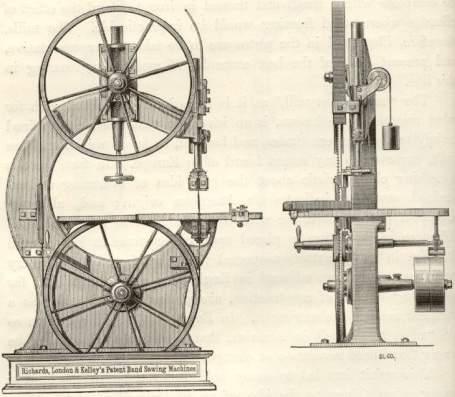This partnership was the third in a series that owned and operated The Atlantic Works in Philadelphia. The namesake partners were John Richards, William E. London, and William S. Kelley.

40" patent bandsaw made by Richards, London & Kelley, 1872. This early bandsaw is strikingly modern in design, with heavy C frame, conveniently located controls, effective blade tension mechanism, and upper and lower blade guides. The only major missing elements are wheel covers.
In roughly 1862 John Richards co-created a partnership, the short-lived Spencer & Richards, based in Columbus, Ohio. In addition, in 1867 to 1870 Richards was inventor or co-inventor on some patents assigned to J. A. Fay & Co. Richards' work with J. A. Fay & Co. is notable because W. E. London worked for the same firm between 1862 and 1867, and probably longer. W. S. Kelley was there in 1866, and perhaps 1867, but by 1868 he and John Richards were listed on a mortising-machine patent that was not assigned to J. A. Fay & Company. Messrs. London and Kelley would figure prominently in Richards' later businesses.
By 1869 Richards had moved to Philadelphia, and that year, along with William H. Thorne, established the partnership of Richards, Thorne & Co.; this firm created The Atlantic Works, a manufactory specializing in woodworking machinery.
In July of 1870, the firm of Richards, Thorne & Company became Richards, Kelley & Co., with control of The Atlantic Works passing to the new partnership. Local patent attorney Charles B. Collier was a silent partner. Just one year later, W. E. London bought out Collier, and the firm became Richards, London & Kelley.
The firm of Richards, London & Kelley was successful and the business expanded greatly. In July of 1877, Richards and Kelley were bought out by Lucien H. Berry and Lymon O. Orton and the firm name became London, Berry & Orton. By this time Richards was living in England. Kelley moved to New Jersey and joined H. B. Smith Machine Co.
The two new partners, Lucien Henry Berry and Lyman Osgood Orton, were already both employees and machine designers for the firm. Orton had likely worked for J. A. Fay & Company—his older brother, Gerrit V. Orton, definitely did, and Lyman was a witness on one of Gerrit's patents. Gerrit went on to form the Orton Machine Co. in San Francisco. As for Berry, we have not found any information on his activities before joining The Atlantic Works.
In March of 1888, London left the partnership and the name became Berry & Orton Sometime around 1892 the Works were incorporated as Atlantic Works, Inc.; the "Berry & Orton" name continued to be used for a few years but then it seems that it was dropped in favor of "Atlantic Works, Inc." It is difficult to be certain about this and about how long the business survived, as information seems to fade away after the mid-1890s. The latest semi-reliable data point we have seen is from 1912.
To summarize the years of operation,
Some machines were labeled simply as "The Atlantic Works" even though they were made by one of the above partnerships, not necessarily by "Atlantic Works, Inc."
John Richards
John Richards was a prolific author and inventor, who has the following books available through Google Books:
According to an ad on the back of the Centrifugal Pumps book, Richards was also the editor of Industry , a Monthly Magazine devoted to Science, Engineering, and Mechanic Arts especially on the Pacific Coast. The magazine was produced by the Industrial Publishing Company, San Francisco, and began publication in 1888.
Richards also received many woodworking-machinery patents. There are 1862 and 1865 patents to John Richards of Columbus, OH, for scroll saws and mortisers. There are 1867 patents to John Richards of Cincinnati, OH, and these inventions were co-held by J. A. Fay & Co. president William H. Doane. A Dave Potts posting to the oldtools list provides more background on Richards.
John Richards of Cincinnati also received a pair of 1868-1869 mortiser patents. Then, an 1870 planer patent (103,080) was granted to John Richards of Philadelphia and assigned to J. A. Fay & Co. This patent is the "smoking gun" that links that Ohio-based John Richards with the Philadelphia-based John Richards. Later that year, Richards received a bandsaw patent that was not assigned to J. A. Fay & Co. Since Richards had relocated to a city that did not have a J. A. Fay & Co. presence, it is likely that he had left the company by that time (the former 1870 patent was probably applied for before he left, but granted after he left).
Information Sources
- Dave Potts has provided much of the information here. Dave mostly performed his research the old-fashioned way: through library visits and correspondence.
- The Hagley Museum has a catalog and other materials from this firm, dating from 1873-1874.
- The 1874 work, Wiley's American iron trade manual of the leading iron industries of the United States, has this entry: "RICHARDS LONDON & KELLY [sic]. North 20th Street. Wood working and sawing machinery. This firm has introduced a variety of new and ingenious machines for the specialty, many of which have received commendation abroad as well as in this country."
- Listed in a work published by the United States Centennial Commission, Official Catalog of the 1876 International Exhibition, as a maker of "wood-cutting machinery".
- The 1891 book, Philadelphia and Popular Philadelphians, published by "The North American" newspaper, provides the timeline given above. The lengthy passage is quoted in full under the entry for Berry & Orton.
- A search of Google Books produced many small tidbits of information that supplement the more major references given above.